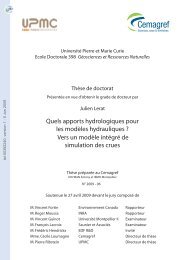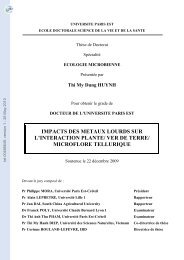La conservation de la nature en Afrique centrale entre théorie et ...
La conservation de la nature en Afrique centrale entre théorie et ...
La conservation de la nature en Afrique centrale entre théorie et ...
- No tags were found...
You also want an ePaper? Increase the reach of your titles
YUMPU automatically turns print PDFs into web optimized ePapers that Google loves.
Architecture <strong>de</strong> <strong>la</strong> base <strong>de</strong> donnéesLes critères quant au choix <strong>de</strong>s sections <strong>et</strong> champs à r<strong>en</strong>seigner au sein <strong>de</strong> <strong>la</strong> base <strong>de</strong> donnéesont été définis par rapport à l’ag<strong>en</strong>cem<strong>en</strong>t habituellem<strong>en</strong>t admis pour <strong>la</strong> prés<strong>en</strong>tation d’uneinitiative, c’est à dire l’ag<strong>en</strong>cem<strong>en</strong>t dit <strong>en</strong> cadre logique : généralités, moy<strong>en</strong>s humains <strong>et</strong>techniques, contexte, objectifs, actions, résultats, évaluation, recommandations.Les informations re<strong>la</strong>tives aux initiatives CBNRM à intégrer dans <strong>la</strong> base <strong>de</strong> données, ont étécollectées parmi les ressources mises <strong>en</strong> ligne sur Intern<strong>et</strong>, les rapports <strong>de</strong> missions <strong>et</strong> rapportsd’évaluation <strong>de</strong> proj<strong>et</strong>s, les dossiers <strong>de</strong> subv<strong>en</strong>tion soumis aux bailleurs <strong>de</strong> fonds, les bases <strong>de</strong>données existantes <strong>et</strong> <strong>de</strong>s <strong>en</strong>tr<strong>et</strong>i<strong>en</strong>s <strong>de</strong> personnes-ressources (interv<strong>en</strong>ants internes ouexternes à l’initiative) quand ce<strong>la</strong> était possible.tel-00508990, version 1 - 9 Aug 2010Le format finalisé <strong>de</strong> <strong>la</strong> base <strong>de</strong> données a été divisé <strong>en</strong> seize sections. <strong>La</strong> totalité <strong>de</strong> <strong>la</strong> base <strong>de</strong>données a été rédigée <strong>en</strong> ang<strong>la</strong>is. <strong>La</strong> partie supérieure <strong>de</strong> <strong>la</strong> base <strong>de</strong> données représ<strong>en</strong>te <strong>la</strong>section ‘’G<strong>en</strong>eralities’’ (trad. Généralités) (Annexe 1). Chaque initiative a été détaillée parl’intermédiaire <strong>de</strong> quinze ongl<strong>et</strong>s, exploitables dès lors que l’utilisateur clique <strong>de</strong>ssus. Chaqueongl<strong>et</strong> représ<strong>en</strong>te une section différ<strong>en</strong>te. L'organisation <strong>de</strong>s ongl<strong>et</strong>s suit dans <strong>la</strong> mesure dupossible l’ag<strong>en</strong>cem<strong>en</strong>t usuellem<strong>en</strong>t employé lors <strong>de</strong>s prés<strong>en</strong>tations <strong>de</strong>s initiatives, à savoirl’ag<strong>en</strong>cem<strong>en</strong>t dit <strong>en</strong> cadre logique.1. Généralités :<strong>La</strong> section « Généralités » visible <strong>en</strong> perman<strong>en</strong>ce par l’utilisateur, r<strong>en</strong>seigne sur lesinformations ess<strong>en</strong>tielles <strong>et</strong> basiques re<strong>la</strong>tives aux initiatives CBNRM à capitaliser. Le champ‘’Project/Programme Name’’ (trad. Nom du proj<strong>et</strong>/du programme) r<strong>en</strong>seigne sur le nomcompl<strong>et</strong> <strong>et</strong>, si possible, l’acronyme <strong>de</strong> l’initiative. Le champ ‘’N° (Inc Auto)’’ indique l<strong>en</strong>uméro d’<strong>en</strong>trée <strong>de</strong> l’initiative au sein <strong>de</strong> <strong>la</strong> base <strong>de</strong> données (attribué automatiquem<strong>en</strong>t par lelogiciel Microsoft®ACCESS). Le champ ‘’Time Frame’’ (trad. Dé<strong>la</strong>is) se divise <strong>en</strong> souschamps‘’Start’’ (trad. Début) <strong>et</strong> ‘’End’’ (trad. Fin), indiquant respectivem<strong>en</strong>t les dé<strong>la</strong>is <strong>de</strong>l’initiative, <strong>la</strong> date officielle <strong>de</strong> comm<strong>en</strong>cem<strong>en</strong>t <strong>et</strong> <strong>la</strong> date officielle <strong>de</strong> clôture. Le champ‘’Status’’ (trad. Situation) indique, selon <strong>de</strong>ux choix, l’état d’avancem<strong>en</strong>t <strong>de</strong> l’initiative. Lechamp ‘’Location’’ (trad. Emp<strong>la</strong>cem<strong>en</strong>t) r<strong>en</strong>seigne sur le lieu d’interv<strong>en</strong>tion <strong>de</strong> l’initiativeavec le pays <strong>et</strong> l’échelle <strong>de</strong> c<strong>et</strong>te interv<strong>en</strong>tion. Le champ ‘’Geographical Coverage’’ (trad.Couverture géographique) détaille <strong>la</strong> couverture géographique <strong>de</strong> l’initiative, notamm<strong>en</strong>t parl’intermédiaire du bouton ‘’See map’’ (trad. Voir carte) qui peut perm<strong>et</strong>tre à l’utilisateur <strong>de</strong>visualiser cartes <strong>et</strong> photos <strong>de</strong> <strong>la</strong> zone d’interv<strong>en</strong>tion. Le champ ‘’Implem<strong>en</strong>ting Organisation’’(trad. Organisation participante) r<strong>en</strong>seigne sur l’organisation maître d’ouvrage <strong>de</strong> l’initiative.Le champ ‘’Funding partners’’ (trad. Part<strong>en</strong>aires financiers) r<strong>en</strong>seigne sur les part<strong>en</strong>airesayant subv<strong>en</strong>tionné l’initiative. Le champ ‘’Thematic Area of Focus’’ (trad. Champsthématique) indique, selon neuf choix, <strong>la</strong> ou les thématiques d’action <strong>de</strong> l’initiative. Le champ‘’Type of <strong>La</strong>ndscape’’ (trad. Type d’espace) indique, selon quatre choix, le type d’espace surlequel l’initiative intervi<strong>en</strong>t. Le champ ‘’Keywords’’ (trad. Mots-clé) précise <strong>de</strong>s mots-clésreprés<strong>en</strong>tatifs <strong>de</strong> l’initiative. Le champ ‘’Research an existing evaluation grid’’ (trad.Recherche d’une grille d’évaluation existante) perm<strong>et</strong> à l’utilisateur d’accé<strong>de</strong>r directem<strong>en</strong>t àl’<strong>en</strong>semble <strong>de</strong>s initiatives <strong>en</strong>registrées dans <strong>la</strong> base <strong>de</strong> données. Les champs ‘‘Status’’,‘’Location’’, ‘’Thematic Area of Focus’’, ‘’Type of <strong>La</strong>ndscape’’ <strong>et</strong> ‘’Research an existingevaluation grid’’ possè<strong>de</strong>nt chacun une liste dérou<strong>la</strong>nte dans <strong>la</strong>quelle l’utilisateur doit- 393 -
















